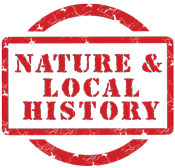Once a Beautiful River
By Jack Ewing
A few short years ago I wrote an article about the Barú River and the otters that could still be seen there at that time. (Read it HERE.) I proclaimed that the Barú was the most beautiful river on the Pacific Coast of Costa Rica, proudly stated that no other river bridge on the coastal highway could boast such a magnificent view, and expressed the hope that the community of Dominical would fight to keep it that way. At the time there were a number of companies trying to acquire permits to extract gravel from the river bed. The community of Dominical, having seen the destruction created by the mining of other rivers such as the Naranjo, went before the authorities, opposed the exploitation of the river for removing sand and gravel, and won. Everybody was happy, and the Barú retained its fame as the most beautiful river on the coastal highway. That was about four years ago.
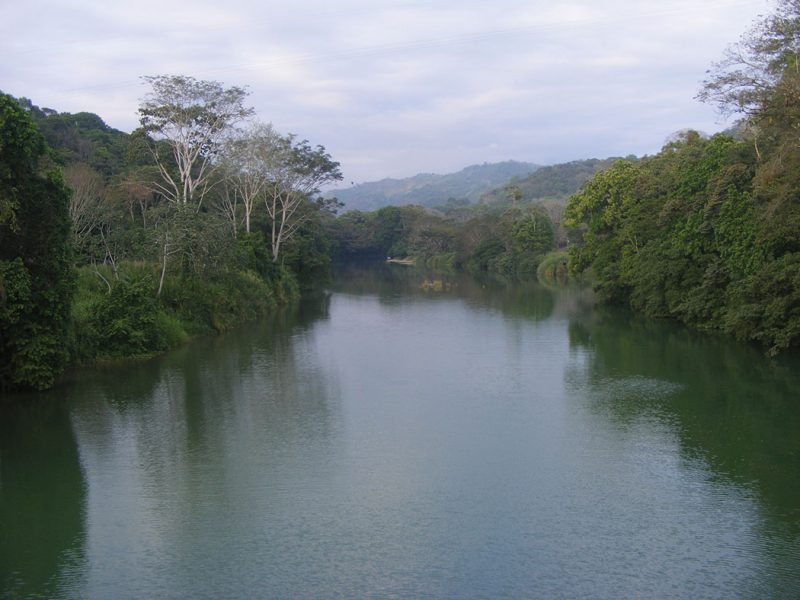
One day in February of 2018 while driving from Hacienda Barú to Dominical I happened to glance up river while crossing the bridge. My God. It’s gone. What happened to that beautiful view? What on earth is that monstrosity running down the middle of the river? I couldn’t believe my eyes. That spectacular view from the bridge, a veritable treasure that distinguished the community of Dominical from so many others whose rivers had already been ruined, had disappeared. Almost overnight it changed from the photo above to this:
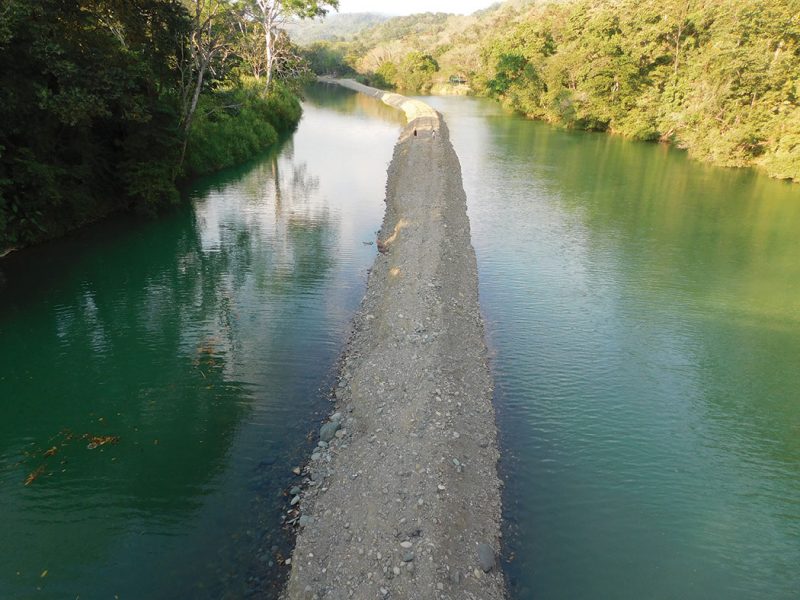
I am not an engineer, but I’m pretty good on common sense, and I can’t even imagine what that aberration of sand and gravel running down the middle of the river is supposed to accomplish. I suspect that it has something to do with protecting the property of people downstream who have chosen to build homes and businesses on the floodplain of a major river. As often happens when you try to alter nature it will most certainly bring some unexpected and unwelcome consequences which nobody can predict. I breathed a sigh of relief at the thought. Of course the new dike is only temporary. When Mother Nature decides that the time is right she will remove it and give us our view back.

It’s Not a Good Idea to Mess With Mother Nature. She Usually Comes Back and Bites You.
I remember a project on the Savegre River a few years back when somebody was going to build a “water park” partly on the floodplain and partly right in the river bed of a side channel. How on earth they got permission to proceed with the project I will never know. One day the project manager came to see me and was telling me how wonderful the water park was going to be. “Aren’t you worried about the river?” I asked. “The Savegre can be brutal when fed by heavy rains.”
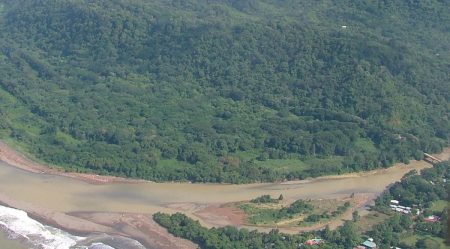 “Oh no”, he replied. “We’ve done our homework. This construction is going to be so solid that it would take the proverbial 100 year flood to wash it away, and that flood happened a couple of years ago. It’s not likely to come along again for a long time.” He was referring to the torrential rains that accompanied some minor hurricane or other a couple of years earlier. I probably should have told him about hurricanes Joan in 1988 and Cesar in 1996, but he was very sure of his facts, and wasn’t interested in hearing anything to the contrary from me.
“Oh no”, he replied. “We’ve done our homework. This construction is going to be so solid that it would take the proverbial 100 year flood to wash it away, and that flood happened a couple of years ago. It’s not likely to come along again for a long time.” He was referring to the torrential rains that accompanied some minor hurricane or other a couple of years earlier. I probably should have told him about hurricanes Joan in 1988 and Cesar in 1996, but he was very sure of his facts, and wasn’t interested in hearing anything to the contrary from me.
Six months later, and who knows how many hundreds of thousands of dollars invested in the project, some hurricane, whose name nobody even remembers, carried the whole project down river. So much for doing your homework. When the river wants to go somewhere it couldn’t care less what obstacles humans have placed in its path. It just goes there.
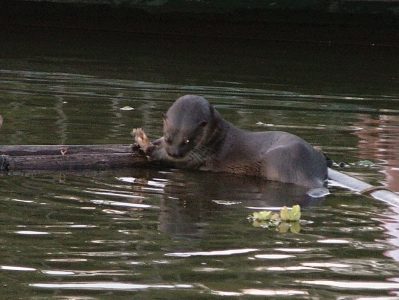 Hurricane Joan brought torrential rains for five days. Much of Dominical flooded. The bodies of about 50 head of cattle washed up on the beaches on both sides of Dominical.
Hurricane Joan brought torrential rains for five days. Much of Dominical flooded. The bodies of about 50 head of cattle washed up on the beaches on both sides of Dominical.
Hurricane Cesar was fast and furious but did a tremendous amount of damage. We were isolated from San Isidro and Quepos and without electricity for six days. Cesar eroded river banks throughout the region and carried thousands of tree trunks out to sea. Most of these ended up on the beaches. I am not exaggerating when I say that it was possible to walk on tree trunks for the six kilometers from the mouth of the Barú River to the mouth of the Hatillo Viejo River and never set foot on sand. When I look at the photo of our new dike, I wonder what would happen in a torrential storm with hundreds of tree trunks washing over the top of it. Water is a life giver, but it can also be a truly formidable foe.
The biggest hurricane to affect this region that anyone remembers was Janet in 1955. You can read more about Janet in my article in last month’s Quepolandia. ( Read it HERE.) According to the the late Manuel Angel Sanchez, who was foreman of Hacienda Barú in 1955, the Barú river rose so high that it almost reached his doorstep, which was 4 meters above the normal water level, and stayed that high for 5 days. He also said that the only place in Dominical that was relatively safe during the worst of the flood was the second story of the Dominical Hotel, located where today stands the El Coco Restaurant. When the waters receded half meter of mud and silt remained on the first floor.
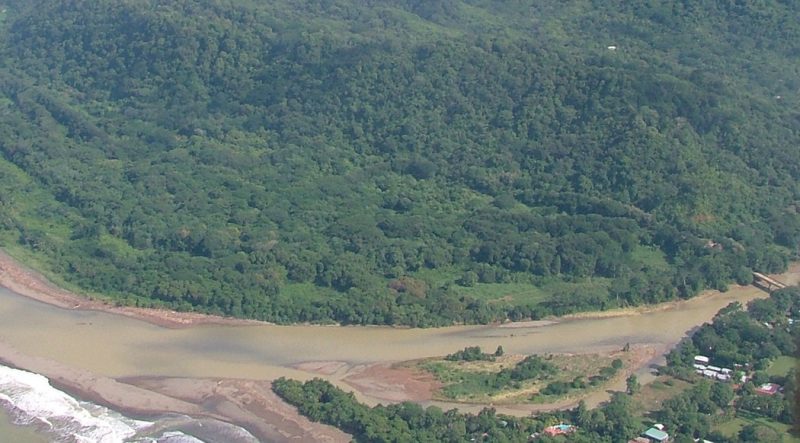
I took the above photo from an ultralight plane on October 1, 2005, two days after Tropical Storm Stan which later grew to hurricane strength and wreaked havoc further north in Central America and Mexico. It’s effects were relatively mild in Costa Rica. The most serious damage in this part of the country took place in the community of Portalón about 15 km north of Domincal. The town was flooded and the bridge totally destroyed. The reason I show this photo is because it may be the last aerial photo taken of the mouth of the Barú in its natural state. In the following years a number of human interventions occurred. No one knows what the next few hurricane seasons will bring, but one thing is for sure. The river will never be the same again. It will be interesting to see what happens to the new dike or river wall or whatever it’s called in the future. Hopefully Mother Nature will restore that magnificent view.

